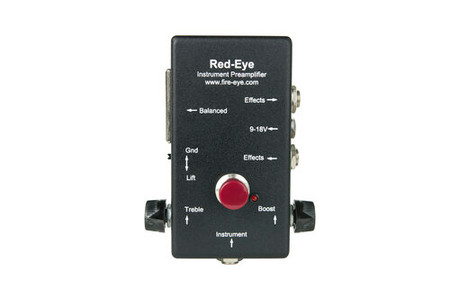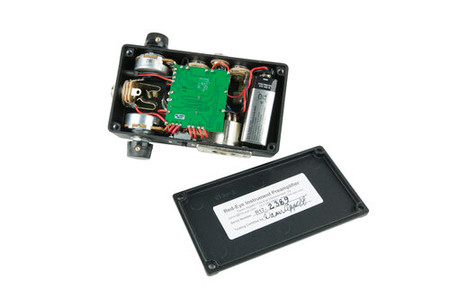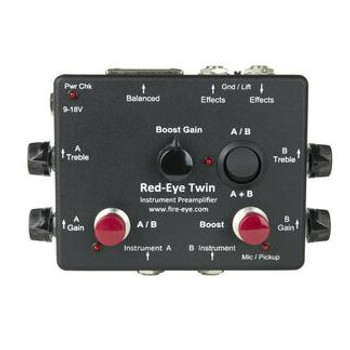Fire-Eye
Red-Eye Instrument Preamplifier
We ship worldwide! (Read this)
- FREE SHIPPING:
- to all 50 US States
Description
The Red-Eye preamp can be a simple, and very effective, solution for getting pure sound with high-impedance piezoelectric pickups -- you know, the kind very commonly found on upright basses (as well as many electric uprights). In fact, they are specifically designed to interface well with instruments having passive or active piezo pickups -- but they can also be used for those with magnetic pickups such as electric guitars and electric basses.
When I got these in, once I opened them up, it was obvious that the guys at Fire-Eye put a strong emphasis on high-quality components, clean design, and impeccable construction. There are some bells and whistles, but they forego some features for a straight up killer sound and not a lot of opportunities to pick up "junk" in the signal path.
 A couple important things to note about the Fire-Eye preamp, which set it apart from other common preamps:
A couple important things to note about the Fire-Eye preamp, which set it apart from other common preamps:
- EQ controls are limited. The only EQ on this preamp is a treble control; it is useful for removing the clack, but it is set high in the frequency range. But the buffering is so well done, you should hardly need much EQ, if any, to get a great sound.
- There is not a labeled 1/4" output. However, the "Effects Loop Out" doubles as a 1/4" output, so if you're using it with your onstage amp, you can send the 1/4" to your regular instrument input. However, if you send your signal to a mixing board or an amp equipped with a "microphone" input on an XLR, the DI out is the preferred output - it is much better for reducing noise over long cable runs, so if you're a long way from your amp, you can feel confident that you won't be getting a lot of ugly interference.
How does it sound? Here's the tech-speak from Fire-Eye: The Red-Eye Preamp’s impedance-matching field-effect transistor input circuit is designed especially to match and track the impedance of passive piezoelectric pickups. That results in a smooth, natural, balanced, acoustic instrument tone. Low distortion, low noise, and generous headroom mean that clear tone comes through even when an instrument is played percussively and loudly.
They use some big words, there, but in my testing here at the shop, I've gotta say the thing made our Realist-equipped double bass, as well as an NS Design WAV4 electric upright, sound great with no knob-tweaking at all.
That said, if you are someone who likes to twiddle knobs and dial in a tone, the preamp is equipped with an effects loop; you can use outboard effects (pedals, modules) to create exactly the sound you're after.
The boost feature is handy: use it to switch volumes for arco/pizzicato passages (arco through a pickup is always louder - here's a quick volume switch to accommodate that.) Or use the boost for when you take a solo.
So the straight dope is that this is a purpose-built high-impedance buffering preamp, with an emphasis on clean, uncolored sound. Tonal purists will totally dig this thing.
If you need a second channel to do blending or switching, check out the "Twin" model.
Features:
- Input: Impedance-matching, accepts up to 2 volt peak-to-peak level without distortion.
- Low-impedance, balanced, XLR output, 600 ohms with ground-lift switch,
- Boost button with volume control for amplifying solos.
- Treble control to boost or reduce treble. Response is flat when control is centered.
- Usually powered by 48-volt XLR phantom power but has an internal 9-volt battery and a 9 to 18-volt center-negative, center-ground, power jack as alternatives.
- Long 9-volt battery life (~200 hours). Battery is not used if other power is present.
- Plugging an instrument in or connecting external power turns the Red-Eye on.
- Pwr Chk Light illuminates for about a second if power is good when the preamp is powered up. When powered up on the battery, the light will appear if the battery is in thefirst 3⁄4 of its life.
- 1⁄4 inch output and input for effects accessory loop, suitable for stomp-tuners or effects pedals or for output to on-stage guitar amps or PAs.
- Internal filtering to reject radio-frequency interference from neon lights and cell phones.
- Small Chassis Size: 1.25 x 2.25 x 4.25 inches. Weight: 10 ounces.
The preamp can be powered by an internal 9v battery (included), an external power supply (9v-18v, optional), or by phantom power supplied through the XLR output.
Product Manual
Need to figure out some of the more in-depth features of this product? Here's a copy of the manual, in PDF format, here.
You may wish to visit the manufacturer's website to see if a more recent version is available.
1 Review
-
(near) perfect for me
I have had my Red Eye for about 4 years now. It makes everything I throw at it (bass, of course, but also electric and acoustic guitars and acoustic mandolin) sound better. The controls are simple. It makes every piezo system I have used with it sound more "microphone-like." It adds clarity to every magnetic pickup instrument I have used it with. The treble control has been really useful for all instruments. For bass, it is really helpful to take out the finger noise without losing brightness and attack. My NS Designs NXT (passive) bass sounds great without it, and it sounds fantastic with it. It just sounds more "solid" almost as if it is removing or preventing some sort of comb filtering from occurring in the passive signal. I use this as my first pedal for all my instruments, whether I am going direct into the board or using an amp only or both (e.g., amp as on-stage monitor or for on-stage volume). You can easily do both with it with a simple MFF y splitter cable. The only complaint I have is that the placement of the effects loop on the right and the balanced output on the left is not really "pedalboard friendly" but that is a really minor complaint in the scheme of things.















